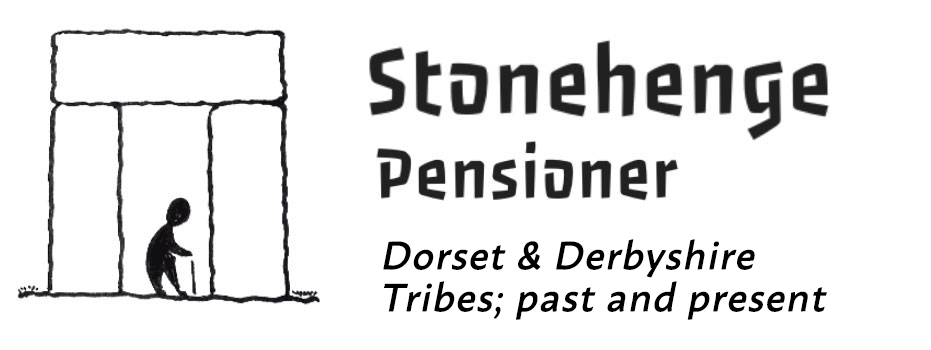Friars Cliff Walk in Christchurch Dorset
Friars Cliff is a picturesque seaside hamlet and has always appealed to the retired but did you know it has a prehistoric past? Join Ken, the pensioner and Zuri, who lived and foraged here in 2200BC, on a walk around this attractive seaside location.
Distance: About 2 miles
Parking: In Pay and Display car park on Southcliffe Road or free on most roads from October to April.
Seating: Ample in the nature reserve, at Highcliffe Castle and on seafront.
Dogs: No restriction.
Disability Access: Wheelchair accessible to the castle only. The latter part of the walk below the cliffs can be accessed by returning through the nature reserve and using surfaced paths down to the beach and back along the sea wall.
Toilets: At far side of “green space” and at Highcliffe Castle (disability access).
Refreshments: At Highcliffe Castle and at The Beach Hut Cafe on seafront.
Start: At entrance to Glengarry Way (postcode: BH23 4EH) adjacent to the car park on Southcliffe Road. Walk down Glengarry Way to a small open space on the left side and opposite Vecta Close. This plot is home to our oldest resident, beneath a Bronze Age tumuli; an ancient grave which has not been excavated. Beneath are the bones of a male warrior or perhaps a woman. In fact it was a woman in the nearest known tumuli to here on Hengistbury Head. These interments took place around 1500BC, around 700 years after Zuri lived here, and 1500 years before the Romans arrived. Think about where these people came from as you continue the walk.
The three largest trees on the open space are silver birch. It is possible to ‘tap’ the tree bark in spring and collect the clear sap for drinking. The media reported a few years ago that this “paleo food” would replace coconut water, as it is nutritious and said to be good for the skin. Further research is needed because this fluid contains saponins and these can be harmful.
: Walk down Vecta Close, don’t turn down the left path but take the ‘cut’ straight ahead through the hawthorn and oak copse onto the ‘green space’ with views to the Needles off the Isle of Wight. (Toilets in the right hand corner towards the sea)
: Turn left and follow the copse and garden boundary, cross the tarmac path, up two steps and beneath the pines onto a picnic area. Wheelchairs can avoid the steps by going left and then right via the road.
In front of you is the concrete base of a radome, which was like a large white golf ball and protected a 40 foot aerial dish. This area was a Ministry of Defence site from the Second World War to 1980, firstly with radar and then satellite tracking. An information plaque is nearby on a large chunk of Portland stone.
This was heathland when Zuri lived in what is now Christchurch. She foraged here when she needed certain plants, but it was a tough walk. There were no bridges so she had to wade across the River Avon and then through the Stanpit marshes. If she was here at dusk she would hear the “chur” of the nightjars, which can now only be heard on nearby St. Catherine’s Hill, or in the New Forest, in spring.
: Walk over the grass to the far corner, keeping the lane and Christchurch Windsurfing Club building on your left side, and pass through the pedestrian gate into Steamer Point Nature Reserve.
A sign explains why this spot is called Steamer Point. Pause in the recess with a seat overlooking the beach and sea wall used on the return. The sand on the beach, particularly that heading west from the beach huts, is usually filched by winter storms and dragged out into the bay each year. The beach falls by up to four feet. The sand is recovered by contractors at low tide each June and transported back along the beach using heavy machinery. It is expensive work but is it sustainable? Even with this beach protection, a number of beach huts were destroyed by storms a few years ago.
The beach in front of you changes almost daily according to the tides and longshore drift. Some days pebbles abound, on others pure sand. After storms, seaweed is thrown up and as this rots on the sand it is now considered an important resource for insects and birds. Zuri has reminded me that in her time the hookbeaks (sea eagles) nested in the pine trees and lived all along this coast. Salmon, sea trout and seals were also common. Human intrusions, those of us seeking the picturesque and beach life, are responsible for their demise. Zuri loved this spot, as she could see, over to the right, the entrance to the wonderful sheltered harbour that nurtured her people. Beyond were the abundant marshes, where she found much of her food as fish, bird’s eggs and plants. She gives the landforms that guided seafarers here, animate names. Hengistbury Head, to the right, is the Hill of the Bears Arm, but perhaps she also called the Needles, the Needles. She used bone needles in her work and the similarity of bone and chalk is striking, so why not?
: Continue walking along the track into the nature reserve
The small wartime building on the right serves as an information centre and contains a wealth of information on the flora and fauna in the reserve. The trees are mixed lime, oak, beech, sycamore, sweet chestnut, ash, yew and other species, all once part of Highcliffe Castle gardens. Various Second World War buildings exist amongst the trees.
: Continue walking on the surfaced road, watchful for cyclists and the occasional vehicle.
Pass two pools on the left, one with a viewing platform.
Follow ‘Highcliffe Coast Path’ signs. Pass the lodge on the right, now a holiday let and continue around the fencing, keeping right and into a picnic area overlooking the sea.
At the fence, note how here, the mighty English oak to the left is a stunted dwarf on this windblown spot, with its poor heathland soil. Abundant lichens, which indicate the pure air of this location, adorn the branches and trunk. You might wonder how Zuri came here. It was simple; her people had walked here! After the last Ice Age 10,000 years ago, her forebears had worked their way north, hunting along the Atlantic coast of France and because the Channel had yet to flood, arrived here. Not quite here, as the coast was further out. When sea levels rose and flooded the Channel, they still paddled (or sailed?) between the two lands. What we now call Christchurch Harbour was only just developing in Zuri’s day. It progressively flooded as sea levels rose because Ice Age glaciers were continuing to melt and retreat northwards.
Our present day pensioner tribe love this spot and donate picnic tables as memorials, memento mori, so that we can relax and ponder on all those generations who went before us. It is around 125 generations back to Zuri!
: Continue across the picnic area to a gap in the fence where you rejoin the path turning right and towards the castle. Continue until you are above the 117 steps down to the beach.
As you near the steps, note the huge old Monterey pines on the right. If you find some pine needles on the ground beneath these trees they will come in groups of three. The needles from other pines in the grounds come in two’s. Also the Monterey pines have a mass of old cones hanging beneath the upper branches. They burst if fire spreads through the tree and release the winged seeds in the cones over the burnt ground. Touch the wonderful fissured bark of the trunk before moving on.
At the top of the steps, consider the grove of Holm oak, where the dead leaves on the ground give this species away. As the photograph shows, the leaves remain on the ground and do not decompose. This is because they contain perhaps the highest level of lignin in any tree and are resistant to breakdown. This feature, plus their rather dark and gloomy look, and the fact that very few insects or birds utilise the tree, give it a poor press with horticulturalists and environmentalists. It is a Mediterranean species and the most common tree in Spain. Its leaves are able to handle hot temperatures as well as dry and cold periods. They close the stomata (breathing holes) on the underside of the leaves and ‘hibernate’ until conditions improve. It has very hard wood, rarely used except as excellent charcoal. Its acorns are rich and loved by Spanish pigs; Iberian acornfed ham is a true delicacy and very expensive. The tree was introduced in Victorian times because it resists salt laden sea winds and so protects gardens like Highcliffe Castle, and Abbotsbury Gardens further west in Dorset. It dominates the sea cliff here, as you will see when you return along the beach. Why does it spread so well? Probably because the jays bury the acorns each autumn in soft soil and forget where many of them are.
: The castle, cafe and toilets are a short walk away to the left, should you wish to detour to them.
High Cliff House preceded the castle in 1775. Only the lodges remain and are now part of the Lord Bute Hotel. Its owner died after falling down the cliffs in 1792 whilst searching for plants. His grandson Lord Stuart De Rothesay built the present day castle between 1831 and 1835 using some medieval masonry shipped over from France to Steamer Point. The castle was badly damaged by fire in 1967 and refurbished in 2007. Its most famous tenant from 1916 to 1922 was Harry Gordon Selfridge. He is said to have coined the phrases, “The customer is always right” and “There are only …… day’s shopping to Christmas”. He is interred in St. Marks Churchyard opposite the Lord Bute Hotel.
:Those who cannot face the steps or in a wheelchair, can return the same way to the Christchurch Windsurfing Club building and use surfaced paths down towards the beach and back along the sea wall.
: To continue the walk, descend the steps and turn right. If walking is tough on the soft sand you can move to the sea edge, where the sand is firmer. Aim for the firmer path which starts beneath the sand cliffs.
At the bottom of the steps look back at the cliffs to right and left to see how the Holm oak, often in bush form, dominates the scene. This is a quiet beach out of season but the beach parties every summer often leaves a mass of beer bottles, cans and packaging. As you walk you will spot the thousands of pieces of charcoal in the sand from beach fires which may take hundreds of years to biodegrade. The sea is still rising each year by around 2 mm which will raise the sea level by half a metre in the next 100 years.
The sand cliffs here were laid down 40 – 50 million years ago. As you reach the wire fence with wood posts, study the cliff face. A myriad of small holes (see photo) rather like a pencil point pushed in, can be seen, especially where the sand appears white. Out of each hole, an ivy bee, often called an ivy miner bee, hatches between September and mid November. The bee feeds on ivy flowers, at their peak at this time and fills each hole with nectar and pollen to nurture the following year’s brood. The females sting, but only when trod on or squeezed. It was an environmental success when this bee first appeared on the Dorset coast in 2001 and it may well have been at this very location.

: Continue along the top of the sea wall.

Three plants are worth noting along the bank. The first is bracken, a tall fern identified by a single frond arising from underground stems called rhizomes (see photo). The back of the frond may be covered in spores, which can create seedlings. In Britain, bracken became a problem because Zuri’s people cut down trees and allowed it to flourish. It may have been controlled through use for thatching, fuel and composting. Bracken dislikes wet soil and favours acidic soil, such as this stretch of sandy heathland. Bracken first appeared 55 million years ago and is the only fern identified as a noxious weed in many parts of the world. It is considered carcinogenic to humans and many animals but only if eaten or repeatedly in contact with those working the land. On the positive side, bracken locks up carbon and helps the environment but it also harbours ticks. These are picked up from animals brushing past and are then able to transfer themselves to dogs, or human bodies. A number of ticks now carry Lyme disease and these have infected walkers and runners who pass through bracken stands in the New Forest.
The second plant seen here in summer is wild carrot, a white flower standing about 30 cm above ground along the pathside (see photo).This type of flower is called an umbel, similar to the cow parsley seen alongside roads. The giveaway for wild carrot is to spot the single red flower sitting in the middle of the white flower. As the flower fades, it folds back into itself forming a distinctive ‘bird’s nest’ shape. My pagan ancestor Zuri eats the leaves in Spring and the roots later in the season, but only if there is nothing better to eat. The roots are often hard and stringy but stewed over a long period would make them palatable. The plant was probably used as an herb first and became the modern carrot after centuries of mutation and selection (see www.carrotmuseum.com for more information).

The third plant is blackberry which covers much of the bank back to the beach huts. It is one of Zuri’s favourite foods and she would be shocked at the way in which the expensive American blueberry has usurped it. As with many American products, especially their cheese and meat, it is an inferior food.
: Walk back along Friars Cliff sea front keeping the beach huts on the right.
Typically, the sea is often calm and flat in the early morning, when the sea swimmers (mostly pensioners) venture out. As the day progresses the sea breeze strengthens and the waves increase. An occasional seal appears off the beach and a dead porpoise washed up in 2017. At low tide, weever fish, about 10cm long, bury themselves in the sand. If you tread on one its dorsal fin can sting and it is extremely painful. Relief is found by putting the foot into the hottest water you can tolerate.
Walk past The Beach Hut Cafe (www.beachhutcafe.co.uk). There are steps up to toilets. Continue to the end of the beach huts and climb the slope to the road, with a wheelchair ramp on the right.
Watch or is it listen, for the sparrows that seem to inhabit this spot. There is always a small flock around. Is flock the right word? Some say a coterie of sparrows, others a quarrel. Whatever, the UK has seen a severe decline in their numbers so it is good to see them flourishing here. Perhaps the question is why?
At the top of the slope you can see the famous pines stretching down Avon Run Road. The first trees in the row you will now recognise as Monterey pines.
:Turn right up the road to return to the start point.



